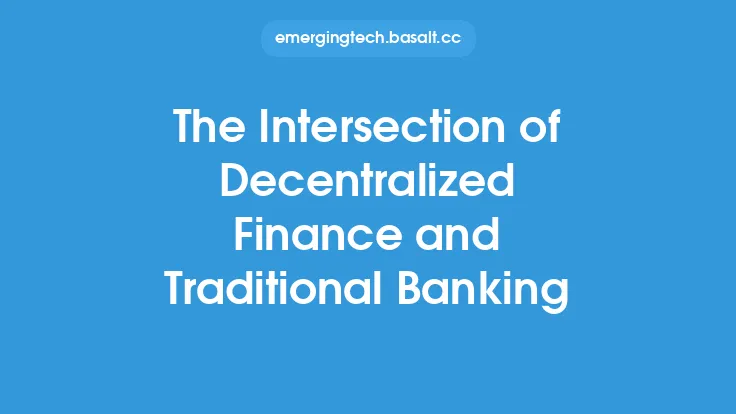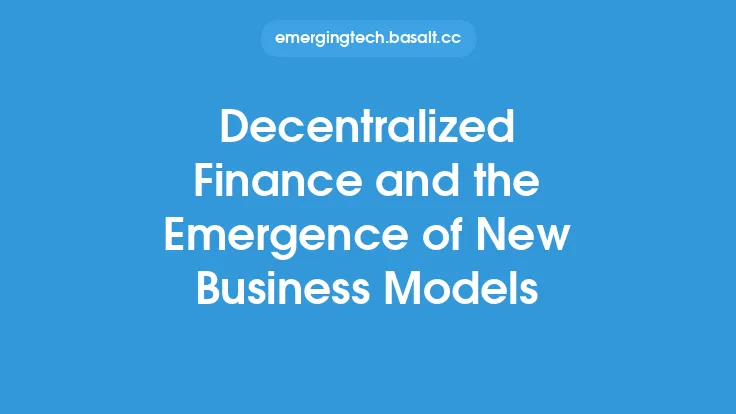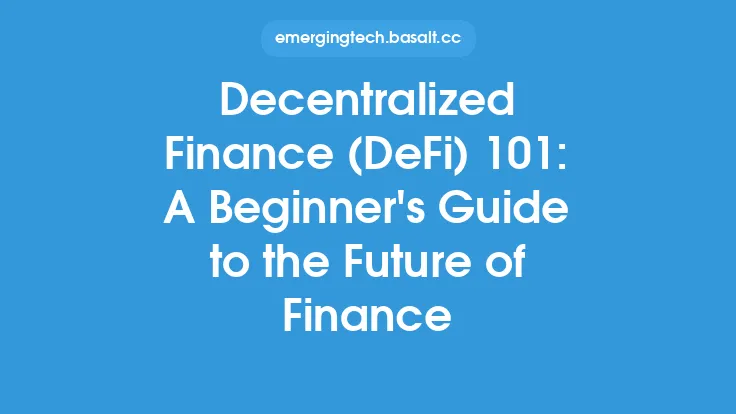The traditional finance system has been in place for centuries, with centralized institutions controlling the flow of money and credit. However, with the advent of blockchain technology, a new paradigm has emerged: decentralized lending. This innovative approach to finance is revolutionizing the way individuals and businesses access credit, and it's changing the game for traditional financial institutions.
Introduction to Decentralized Lending
Decentralized lending, also known as peer-to-peer lending or P2P lending, is a system where individuals or businesses can borrow and lend money without the need for intermediaries like banks. This is made possible by blockchain technology, which enables secure, transparent, and tamper-proof transactions. Decentralized lending platforms use smart contracts to facilitate loans, ensuring that all parties involved are protected and that the terms of the loan are enforced.
How Decentralized Lending Works
Decentralized lending platforms operate on a blockchain network, where lenders and borrowers can interact directly. The process typically involves the following steps:
- Registration: Lenders and borrowers register on the platform, providing necessary information and verifying their identities.
- Credit scoring: Borrowers undergo a credit scoring process, which assesses their creditworthiness and determines the interest rate they'll be charged.
- Loan listing: Borrowers create a loan listing, specifying the amount they want to borrow, the interest rate they're willing to pay, and the repayment terms.
- Lender selection: Lenders browse the loan listings and select the ones they want to fund, based on factors like credit score, interest rate, and loan duration.
- Smart contract execution: Once a loan is funded, a smart contract is executed, outlining the terms of the loan and ensuring that all parties fulfill their obligations.
- Repayment: Borrowers repay the loan, with interest, according to the terms outlined in the smart contract.
Benefits of Decentralized Lending
Decentralized lending offers several benefits over traditional lending systems, including:
- Increased accessibility: Decentralized lending platforms can provide credit to individuals and businesses that may not have access to traditional credit channels.
- Lower interest rates: By cutting out intermediaries, decentralized lending platforms can offer lower interest rates to borrowers.
- Greater transparency: Blockchain technology ensures that all transactions are transparent, tamper-proof, and publicly accessible.
- Improved security: Smart contracts and blockchain technology provide a secure and reliable way to facilitate loans, reducing the risk of default and fraud.
Types of Decentralized Lending
There are several types of decentralized lending platforms, including:
- P2P lending platforms: These platforms connect individual lenders with individual borrowers, facilitating loans between peers.
- Decentralized finance (DeFi) protocols: These protocols provide a decentralized infrastructure for lending, allowing users to borrow and lend cryptocurrencies.
- Token-based lending platforms: These platforms use tokens to represent loans, allowing for the creation of a secondary market for loans.
Challenges and Limitations
While decentralized lending offers many benefits, it's not without its challenges and limitations. Some of the key issues include:
- Regulatory uncertainty: The regulatory environment for decentralized lending is still evolving, and there's a lack of clarity around the rules and regulations that apply.
- Scalability: Decentralized lending platforms can be slow and expensive to use, due to the limitations of blockchain technology.
- Security risks: While blockchain technology provides a secure way to facilitate loans, there's still a risk of smart contract vulnerabilities and other security threats.
- Credit risk: Decentralized lending platforms can be vulnerable to credit risk, as borrowers may default on their loans.
Future of Decentralized Lending
Despite the challenges and limitations, decentralized lending is likely to continue growing and evolving in the coming years. Some of the trends that are likely to shape the future of decentralized lending include:
- Increased adoption: As more people become aware of the benefits of decentralized lending, we can expect to see increased adoption and growth in the industry.
- Improved scalability: Advances in blockchain technology are likely to improve the scalability and usability of decentralized lending platforms.
- Greater regulatory clarity: As regulators become more familiar with decentralized lending, we can expect to see greater clarity around the rules and regulations that apply.
- Increased innovation: Decentralized lending is likely to drive innovation in the financial sector, as new business models and use cases emerge.
Conclusion
Decentralized lending is a revolutionary approach to finance that's changing the way individuals and businesses access credit. By providing a secure, transparent, and tamper-proof way to facilitate loans, decentralized lending platforms are increasing accessibility, reducing interest rates, and improving security. While there are challenges and limitations to decentralized lending, the benefits and potential for growth make it an exciting and rapidly evolving field. As the industry continues to mature, we can expect to see increased adoption, improved scalability, and greater regulatory clarity, driving innovation and growth in the financial sector.





